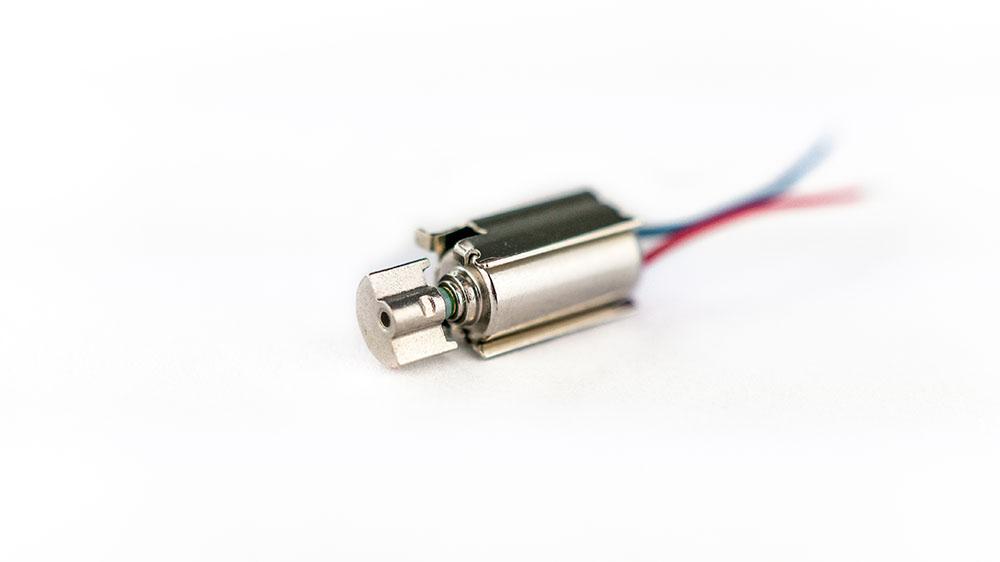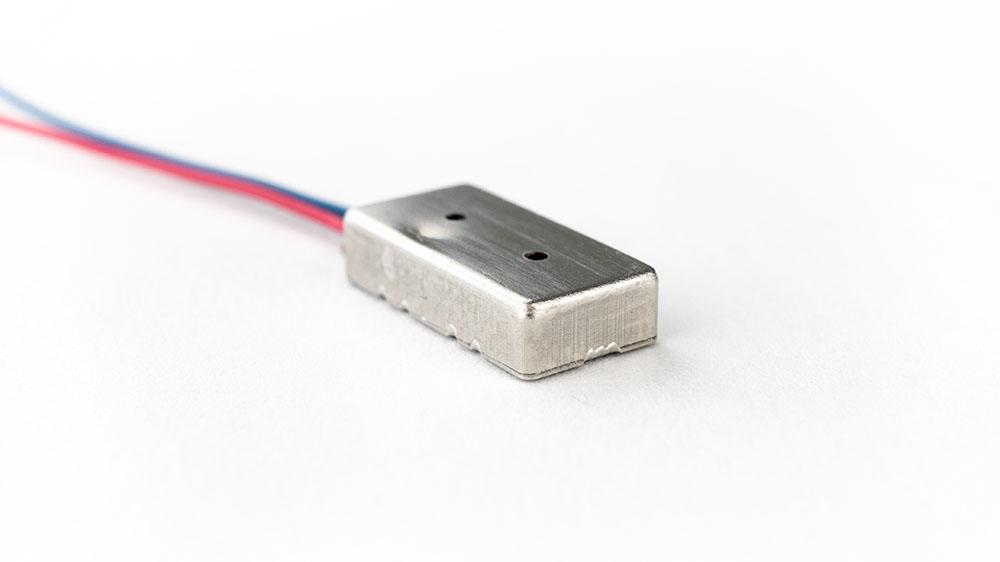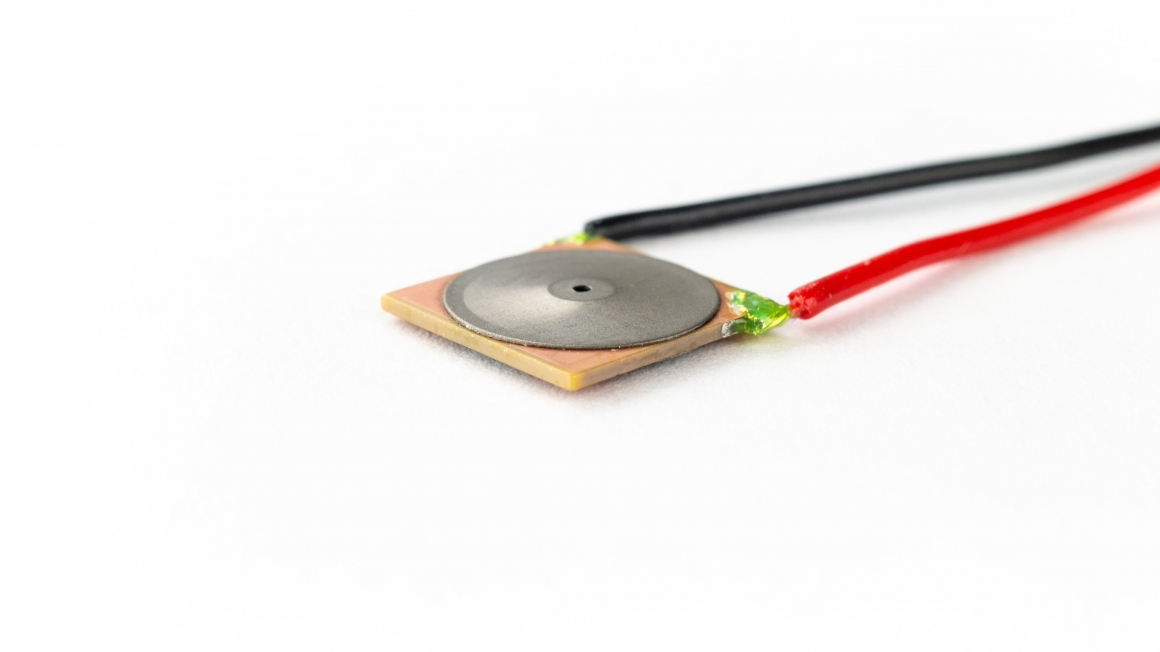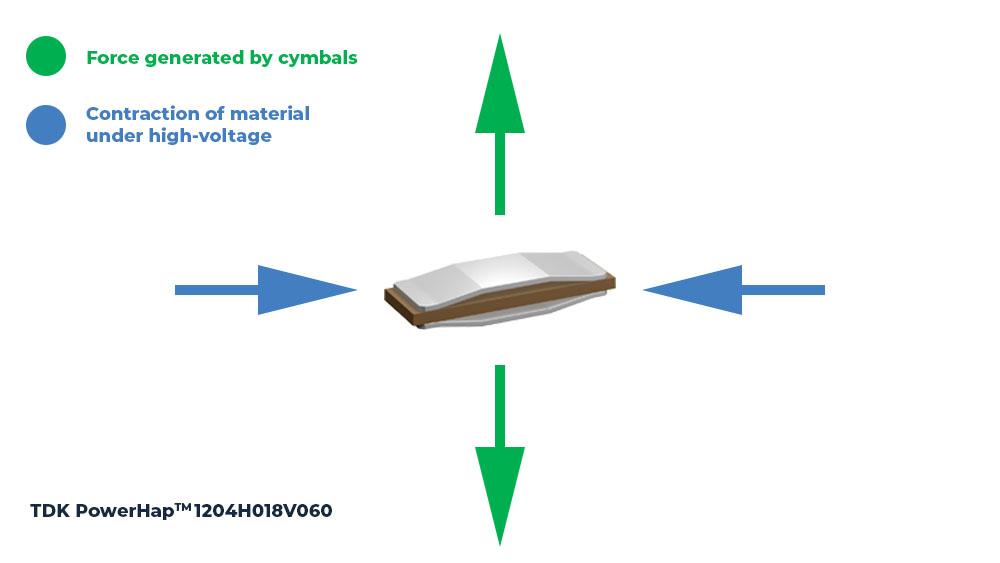Subscribe to EDOM TECH Newsletter
2020/07/06
Mechanical Fundamentals of Piezo Haptic Actuators
The launch of our low-power CapDriveTM piezo haptic driver architecture revived the industry’s interest toward piezo-based tactile effects. Since piezo technologies are different than ERMs and LRAs, we need to share a few mechanical fundamentals in order to optimize their integration. Replacing an ERM or an LRA isn’t simply a matter of attaching a piezo actuator in the same spot with adhesive. Doing so will create disappointing results and will orientate your team in the wrong direction.
Piezo haptics operate under a different mechanical concept and will need a different approach to reach a successful integration with better tactile effects. Let’s see how piezo haptics differentiate themselves from ERMs and LRAs and how it will impact their integration.
Image of open phone with LRA – sticking a piezo actuator here won’t do much more than some light noise.
Understanding Haptic Actuators Comparison Charts – Making Sense of Acceleration
Even if haptic technologies are trying to create advanced effects, they are not able to escape the laws of physics! To understand how haptic actuators work, we need to use some of the most fundamental laws of classical mechanics, Isaac Newton’s laws of motion:
First law
In an inertial frame of reference, an object either remains at rest or continues to move at a constant velocity, unless acted upon by a force.
Second law
In an inertial frame of reference, the vector sum of the forces F on an object is equal to the mass m of that object multiplied by the acceleration a of the object: F = ma. (It is assumed here that the mass m is constant).
Third law
When one body exerts a force on a second body, the second body simultaneously exerts a force equal in magnitude and opposite in direction on the first body.
Comparison charts in haptics are a little bit flawed. The feedback force we feel is the force of motion from the actuator. Why does the industry refer to acceleration to compare feedback strength? The acceleration values you see in comparison charts are based on accelerometer measurement on the same mass for every haptic actuator. Since each actuator is compared on the same mass basis, we can isolate the acceleration value. Therefore, it is true that the actuator with the highest acceleration value will create the strongest feedback, but their performance isn’t measured exactly the same way.
While it might be true that bonding an ERM or an LRA to a given mass will be enough to move it, you can’t expect the same result by bonding a piezo actuator. The piezo actuator’s acceleration value is measured with the mass on top of the actuator. We’ll see why it’s different and why you need to use a different approach to successfully integrate piezo haptics in your product design.
Haptic Actuator Components
We’ve seen that haptics are defined by Newton’s law of motion. To create a force, haptic actuators need two components: a mass and an engine to generate an acceleration to it. When comparing haptic technologies, you are ultimately comparing the type of engine they are using to generate acceleration.
Haptic Actuator = Engine + Mass
Let’s see the components behind every haptic actuator and we’ll see why you can’t directly replace an ERM or an LRA with a piezo actuator.
Eccentric Rotating Mass (ERM) Actuator Components
 ERMs vibrations are created by rotating an eccentric mass with a DC motor (the engine). The mass movement creates an unbalanced force, therefore vibration.
ERMs vibrations are created by rotating an eccentric mass with a DC motor (the engine). The mass movement creates an unbalanced force, therefore vibration.
While it’s complicated to calculate the movement axis of the eccentric mass, all we need to understand is that the force created by the rotation of the unbalanced mass is transferred to the dc motor. The ERM actuator is bonded to the device at the base of the DC motor so that the vibration induced to the dc motor is then transmitted to the device.
Newton’s motion law principles are respected: The eccentric mass and the engine’s rotation creates a moving force that transfers from the actuator to the device to which it is bonded.
Linear Resonant Actuator (LRA) Components
 LRAs vibrations are created by a suspended magnetic mass driven by a voice coil (the engine). Driving current to the voice coil creates a magnetic field that can move the magnetic mass on the same axis that the springs are aligned.
LRAs vibrations are created by a suspended magnetic mass driven by a voice coil (the engine). Driving current to the voice coil creates a magnetic field that can move the magnetic mass on the same axis that the springs are aligned.
The magnetic mass needs to oscillate near its natural frequency in order to resonate and create the biggest force. The resonant frequency is determined by the mass and the suspension springs’ rigidity.
Here again, Newton’s motion law principles are respected: The suspended magnetic mass (m) movement thanks to the voice coil (a) creates a moving force that is transferred to the device via the springs.
Piezoelectric Actuators Components
 For this example, we’ll use the TDK PowerHapTM piezo actuator line-up since they all share the same design basics. These piezo actuators don’t work like piezo benders. Instead, PowerHapTM actuators mechanically contract when they’re under tension (high voltage). The piezo material contraction force the metal cymbals to expand. This is how the actuator can push against a mass. If you are trying to push a mass on one side of the actuator, the other side needs to lean against a surface that will transmit the force to the device, which has a mass. Again, if your device is summited to a force and has a mass, Newton’s second law dictate that your device will end up vibrating.
For this example, we’ll use the TDK PowerHapTM piezo actuator line-up since they all share the same design basics. These piezo actuators don’t work like piezo benders. Instead, PowerHapTM actuators mechanically contract when they’re under tension (high voltage). The piezo material contraction force the metal cymbals to expand. This is how the actuator can push against a mass. If you are trying to push a mass on one side of the actuator, the other side needs to lean against a surface that will transmit the force to the device, which has a mass. Again, if your device is summited to a force and has a mass, Newton’s second law dictate that your device will end up vibrating.
 The reason why piezo actuators can’t replace legacy technologies directly is because they’re not haptic actuators, they’re engines. Just like the ERM’s DC motor and the LRA’s voice coil, piezo actuators don’t have built-in mass.
The reason why piezo actuators can’t replace legacy technologies directly is because they’re not haptic actuators, they’re engines. Just like the ERM’s DC motor and the LRA’s voice coil, piezo actuators don’t have built-in mass.
If we look at Newton’s motion law principles, the piezo actuator is the engine and generates acceleration (a) but we’re missing the mass (m) to create an impactful motion force.
Does that mean it’s impossible to replace LRAs and ERMs with piezo haptics to vibrate a complete device? No, it means you need to find a mass to move with the piezo actuator to do so and we believe it’s an advantage of the technology! It gives more flexibility to tune piezo haptics to get optimal tactile effects depending on your goal. Combining a piezo actuator to a small mass is perfect for localized feedback and to replace mechanical buttons. Combined with a heavier mass, piezo actuators can create enough force to vibrate the whole device to which it’s bonded. The device can also be the mass itself, like an automobile display. You don’t have that level of flexibility from legacy haptic technologies. (Source: Boréas website)
Piezo haptics operate under a different mechanical concept and will need a different approach to reach a successful integration with better tactile effects. Let’s see how piezo haptics differentiate themselves from ERMs and LRAs and how it will impact their integration.
Image of open phone with LRA – sticking a piezo actuator here won’t do much more than some light noise.
Understanding Haptic Actuators Comparison Charts – Making Sense of Acceleration
First law
In an inertial frame of reference, an object either remains at rest or continues to move at a constant velocity, unless acted upon by a force.
Second law
In an inertial frame of reference, the vector sum of the forces F on an object is equal to the mass m of that object multiplied by the acceleration a of the object: F = ma. (It is assumed here that the mass m is constant).
Third law
When one body exerts a force on a second body, the second body simultaneously exerts a force equal in magnitude and opposite in direction on the first body.
Comparison charts in haptics are a little bit flawed. The feedback force we feel is the force of motion from the actuator. Why does the industry refer to acceleration to compare feedback strength? The acceleration values you see in comparison charts are based on accelerometer measurement on the same mass for every haptic actuator. Since each actuator is compared on the same mass basis, we can isolate the acceleration value. Therefore, it is true that the actuator with the highest acceleration value will create the strongest feedback, but their performance isn’t measured exactly the same way.
While it might be true that bonding an ERM or an LRA to a given mass will be enough to move it, you can’t expect the same result by bonding a piezo actuator. The piezo actuator’s acceleration value is measured with the mass on top of the actuator. We’ll see why it’s different and why you need to use a different approach to successfully integrate piezo haptics in your product design.
Haptic Actuator Components
Haptic Actuator = Engine + Mass
Let’s see the components behind every haptic actuator and we’ll see why you can’t directly replace an ERM or an LRA with a piezo actuator.
Eccentric Rotating Mass (ERM) Actuator Components

While it’s complicated to calculate the movement axis of the eccentric mass, all we need to understand is that the force created by the rotation of the unbalanced mass is transferred to the dc motor. The ERM actuator is bonded to the device at the base of the DC motor so that the vibration induced to the dc motor is then transmitted to the device.
Newton’s motion law principles are respected: The eccentric mass and the engine’s rotation creates a moving force that transfers from the actuator to the device to which it is bonded.
Linear Resonant Actuator (LRA) Components
 LRAs vibrations are created by a suspended magnetic mass driven by a voice coil (the engine). Driving current to the voice coil creates a magnetic field that can move the magnetic mass on the same axis that the springs are aligned.
LRAs vibrations are created by a suspended magnetic mass driven by a voice coil (the engine). Driving current to the voice coil creates a magnetic field that can move the magnetic mass on the same axis that the springs are aligned.The magnetic mass needs to oscillate near its natural frequency in order to resonate and create the biggest force. The resonant frequency is determined by the mass and the suspension springs’ rigidity.
Here again, Newton’s motion law principles are respected: The suspended magnetic mass (m) movement thanks to the voice coil (a) creates a moving force that is transferred to the device via the springs.
Piezoelectric Actuators Components
 For this example, we’ll use the TDK PowerHapTM piezo actuator line-up since they all share the same design basics. These piezo actuators don’t work like piezo benders. Instead, PowerHapTM actuators mechanically contract when they’re under tension (high voltage). The piezo material contraction force the metal cymbals to expand. This is how the actuator can push against a mass. If you are trying to push a mass on one side of the actuator, the other side needs to lean against a surface that will transmit the force to the device, which has a mass. Again, if your device is summited to a force and has a mass, Newton’s second law dictate that your device will end up vibrating.
For this example, we’ll use the TDK PowerHapTM piezo actuator line-up since they all share the same design basics. These piezo actuators don’t work like piezo benders. Instead, PowerHapTM actuators mechanically contract when they’re under tension (high voltage). The piezo material contraction force the metal cymbals to expand. This is how the actuator can push against a mass. If you are trying to push a mass on one side of the actuator, the other side needs to lean against a surface that will transmit the force to the device, which has a mass. Again, if your device is summited to a force and has a mass, Newton’s second law dictate that your device will end up vibrating. The reason why piezo actuators can’t replace legacy technologies directly is because they’re not haptic actuators, they’re engines. Just like the ERM’s DC motor and the LRA’s voice coil, piezo actuators don’t have built-in mass.
The reason why piezo actuators can’t replace legacy technologies directly is because they’re not haptic actuators, they’re engines. Just like the ERM’s DC motor and the LRA’s voice coil, piezo actuators don’t have built-in mass.If we look at Newton’s motion law principles, the piezo actuator is the engine and generates acceleration (a) but we’re missing the mass (m) to create an impactful motion force.
Does that mean it’s impossible to replace LRAs and ERMs with piezo haptics to vibrate a complete device? No, it means you need to find a mass to move with the piezo actuator to do so and we believe it’s an advantage of the technology! It gives more flexibility to tune piezo haptics to get optimal tactile effects depending on your goal. Combining a piezo actuator to a small mass is perfect for localized feedback and to replace mechanical buttons. Combined with a heavier mass, piezo actuators can create enough force to vibrate the whole device to which it’s bonded. The device can also be the mass itself, like an automobile display. You don’t have that level of flexibility from legacy haptic technologies. (Source: Boréas website)






